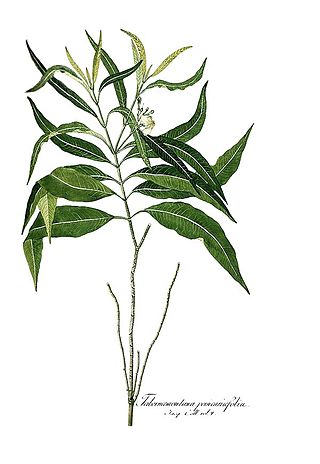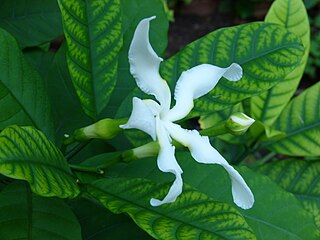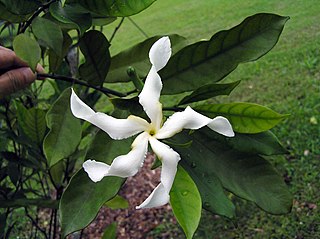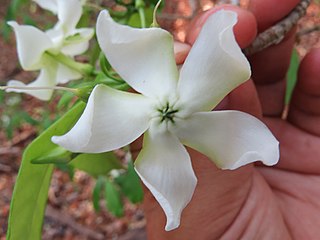
Tabernaemontana is a genus of flowering plants in the family Apocynaceae. It has a pan-tropical distribution, found in Asia, Africa, Australia, North America, South America, and a wide assortment of oceanic islands. These plants are evergreen shrubs and small trees growing to 1–15 m tall. The leaves are opposite, 3–25 cm long, with milky sap; hence it is one of the diverse plant genera commonly called "milkwood". The flowers are fragrant, white, 1–5 cm in diameter.
Tabernaemontana tomentosa is a species of plant in the family Apocynaceae. It is endemic to Mexico.
Tabernaemontana cumata is a species of plant in the family Apocynaceae. It is endemic to the State of Amazonas in northwestern Brazil. The species is listed as endangered.

Tabernaemontana gamblei is a species of plant in the family Apocynaceae. It is endemic to India.

Tabernaemontana alternifolia is a species of plant in the family Apocynaceae. It is endemic to India.
Tabernaemontana oppositifolia is a species of plant in the family Apocynaceae. It is endemic to Puerto Rico.
Tabernaemontana thurstonii is a species of plant in the family Apocynaceae. It is endemic to Fiji.

Tabernaemontana persicariifolia is a species of plant in the family Apocynaceae. It is found in Mauritius and Réunion in the Indian Ocean. The species is listed as endangered.

Cephalopholis panamensis, the Pacific graysby or Panama graysby, is a species of marine ray-finned fish, a grouper from the subfamily Epinephelinae which is in the family Serranidae which also includes the anthias and sea basses. It is found in the Eastern Pacific Ocean.

Tabernaemontana divaricata, commonly called pinwheel flower, crape jasmine, East India rosebay, and Nero's crown, is an evergreen shrub or small tree native to South Asia, Southeast Asia and China. In zones where it is not hardy it is grown as a house/glasshouse plant for its attractive flowers and foliage. The stem exudes a milky latex when broken, whence comes the name milk flower

Tabernaemontana crassa is a plant in the dogbane family Apocynaceae, native to tropical Africa.

Tabernaemontana elegans, the toad tree, is a shrub or small tree in the family Apocynaceae. It is native to eastern Africa.

Tabernaemontana pachysiphon grows as a shrub or small tree up to 15 metres (50 ft) tall, with a trunk diameter of up to 40 centimetres (16 in). Its fragrant flowers feature white to pale yellow corolla lobes. The fruit is green, almost spherical, up to 15 centimetres (6 in) in diameter. Its habitat is forests from sea level to 2,200 metres (7,200 ft) altitude. Its numerous local medicinal uses include as a styptic, and as a treatment for headache, hypertension and to relieve cramps. The species is native to tropical Africa.

Tabernaemontana ventricosa is a plant in the family Apocynaceae. It grows as a shrub or small tree up to 15 metres (50 ft) tall, with a trunk diameter of up to 30 centimetres (12 in) and has white sap. Leaves are paired and crowded near the ends of branches. They are oblong, leathery and a glossy dark green. Flowers are fragrant with white, somewhat twisted lobes, often with a pale yellow center and are set in small clusters at the ends of branches. The fruit is dark green, set in spreading pairs of ellipsoids or oval, beaked pods, up to 10 centimetres (4 in) in diameter. Its habitat is forests from sea level to 1,850 metres (6,000 ft) altitude. In Zimbabwe, it is usually found as part of the understorey of evergreen forests. Local medicinal uses include the treatment of wounds, fever and hypertension. The plant is native to tropical central and southern Africa.
Tabernaemontana stapfiana is a medium-sized tree in the family Apocynaceae. Its flowers feature white with yellow-throated corolla lobes. The fruit is fleshy grey-green, in pairs, each up to 20 centimetres (8 in) in diameter and weighing up to several kilograms. Its habitat is montane evergreen forests from 700–2,000 metres (2,300–6,600 ft) elevation. The plant is native to an area of Africa from Uganda south to Mozambique.

Tabernaemontana macrocarpa grows as a shrub or tree up to 30 metres (100 ft) tall, with a trunk diameter of up to 50 centimetres (20 in). The bark is yellowish brown, brown, grey-brown or grey. Its fragrant flowers feature combinations of cream, white and orange corolla lobes. The fruit is orange, with paired follicles, each up to 16 centimetres (6 in) in diameter. The specific epithet macrocarpa is from the Greek meaning "with large fruit". Its habitat is forests from sea level to 1,500 metres (5,000 ft) altitude. Tabernaemontana macrocarpa has been used as arrow poison. The species is native to Thailand and Malesia.

Tabernaemontana pandacaqui, known as windmill bush and banana bush, is a species of plant in the dogbane family Apocynaceae.

Tabernaemontana amygdalifolia is a species of plant in the family Apocynaceae. It is native to southern Mexico, Central America, Cuba, Haiti, and northwestern South America.
Tabernaemontana humblotii is a species of plant in the family Apocynaceae. It is found in Madagascar.
Tabernaemontana sessilifolia is a species of plant in the family Apocynaceae. It is found in Madagascar.













